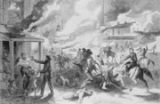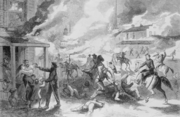
Kansas in the Civil War
Encyclopedia
Even before the outbreak of the American Civil War
, the territory of Kansas had been the scene of fighting between anti-slavery and pro-slavery forces
. The state was admitted to the Union as a free state on January 29, 1861, three months before the opening battle of the war at Fort Sumter
, and at the commencement of the war, the Kansas
government had no well-organized militia, no arms, accoutrements or supplies, nothing with which to meet the demands, except the united will of officials and citizens. During the years 1859 to 1860, the military organizations had fallen into disuse or been entirely broken up.
The Battle of Baxter Springs
, sometimes called the Baxter Springs Massacre, was a minor battle
in the War, fought on October 6, 1863, near the modern-day town of Baxter Springs, Kansas
. The Battle of Mine Creek
, also known as the Battle of the Osage was a cavalry
battle that occurred in Kansas during the war.
On October 25, 1864, a series of three battles occurred, the first two in Linn County, Kansas
, with the final in Vernon County, Missouri. The first was the Battle of Marais des Cygnes
(also called the "Battle of Trading Post"), the second was the Battle of Mine Creek
, and the third was the Battle of Marmiton River
(over the border in Missouri). They were between Major General
Sterling Price
, leading the Missouri expedition
, against Union forces under Major General Alfred Pleasonton
. Price, after going south from Kansas City, was initially met by Pleasonton at Marais des Cygnes
. At the end of the day, the Confederates were forced to withdraw after attacks and assaults by Union forces.
jail, the jail's roof tragically collapsed and killed a number of prisoners. These deaths enraged Missourians. On August 21, 1863, William Quantrill
led Quantrill's Raid into Lawrence
destroying much of the city and murdering over 150 unarmed men and boys. The Confederate
partisans in Missouri rode to Lawrence (a town long hated by Quantrill and many Southerners) in response to the deaths of women and children. Quantrill also rationalized, an attack on this citadel of abolition would bring revenge for any wrongs, real or imagined that the Southerners had suffered. By the time the raid was over, Quantrill and his men had killed approximately 150-200 men, both young and old.

American Civil War
The American Civil War was a civil war fought in the United States of America. In response to the election of Abraham Lincoln as President of the United States, 11 southern slave states declared their secession from the United States and formed the Confederate States of America ; the other 25...
, the territory of Kansas had been the scene of fighting between anti-slavery and pro-slavery forces
Bleeding Kansas
Bleeding Kansas, Bloody Kansas or the Border War, was a series of violent events, involving anti-slavery Free-Staters and pro-slavery "Border Ruffian" elements, that took place in the Kansas Territory and the western frontier towns of the U.S. state of Missouri roughly between 1854 and 1858...
. The state was admitted to the Union as a free state on January 29, 1861, three months before the opening battle of the war at Fort Sumter
Battle of Fort Sumter
The Battle of Fort Sumter was the bombardment and surrender of Fort Sumter, near Charleston, South Carolina, that started the American Civil War. Following declarations of secession by seven Southern states, South Carolina demanded that the U.S. Army abandon its facilities in Charleston Harbor. On...
, and at the commencement of the war, the Kansas
Kansas
Kansas is a US state located in the Midwestern United States. It is named after the Kansas River which flows through it, which in turn was named after the Kansa Native American tribe, which inhabited the area. The tribe's name is often said to mean "people of the wind" or "people of the south...
government had no well-organized militia, no arms, accoutrements or supplies, nothing with which to meet the demands, except the united will of officials and citizens. During the years 1859 to 1860, the military organizations had fallen into disuse or been entirely broken up.
Military activities
The first Kansas regiment was called on June 3, 1861, and the seventeenth, the last raised during the Civil War, July 28, 1864. The entire quota assigned to the Kansas was 16,654, and the number raised was 20,097, leaving a surplus of 3,443 to the credit of Kansas. Statistics indicated that losses of Kansas regiments killed in battle and from disease are greater per thousand than those of any other State.The Battle of Baxter Springs
Battle of Baxter Springs
The Battle of Fort Blair, sometimes called the Fort Baxter Massacre, or the Battle of Fort Baxter was a minor battle of the American Civil War, fought on October 6, 1863, near the present-day town of Baxter Springs, Kansas....
, sometimes called the Baxter Springs Massacre, was a minor battle
Battle
Generally, a battle is a conceptual component in the hierarchy of combat in warfare between two or more armed forces, or combatants. In a battle, each combatant will seek to defeat the others, with defeat determined by the conditions of a military campaign...
in the War, fought on October 6, 1863, near the modern-day town of Baxter Springs, Kansas
Baxter Springs, Kansas
Baxter Springs is a town situated along the Spring River in the extreme southeastern part of Cherokee County, located in southeast Kansas, in the Central United States. As of the 2010 census, the city population was 4,238...
. The Battle of Mine Creek
Battle of Mine Creek
The Battle of Mine Creek, also known as the Battle of the Osage, was a battle that occurred on October 25, 1864 in Kansas as part of Price's Raid during the American Civil War...
, also known as the Battle of the Osage was a cavalry
Cavalry
Cavalry or horsemen were soldiers or warriors who fought mounted on horseback. Cavalry were historically the third oldest and the most mobile of the combat arms...
battle that occurred in Kansas during the war.
On October 25, 1864, a series of three battles occurred, the first two in Linn County, Kansas
Linn County, Kansas
Linn County is a county located in East Central Kansas, in the Central United States. As of the 2010 census, the county population was 9,656. Its county seat is Mound City, and its most populous city is Pleasanton...
, with the final in Vernon County, Missouri. The first was the Battle of Marais des Cygnes
Battle of Marais des Cygnes
The Battle of Marais des Cygnes took place on October 25, 1864, in Linn County, Kansas during Price's Missouri Raid in the American Civil War. It is also called the Battle of Osage, and the Battle of Trading Post...
(also called the "Battle of Trading Post"), the second was the Battle of Mine Creek
Battle of Mine Creek
The Battle of Mine Creek, also known as the Battle of the Osage, was a battle that occurred on October 25, 1864 in Kansas as part of Price's Raid during the American Civil War...
, and the third was the Battle of Marmiton River
Battle of Marmiton River
The Battle of Marmiton River occurred on October 25, 1864, in Vernon County, Missouri during the American Civil War....
(over the border in Missouri). They were between Major General
Major General
Major general or major-general is a military rank used in many countries. It is derived from the older rank of sergeant major general. A major general is a high-ranking officer, normally subordinate to the rank of lieutenant general and senior to the ranks of brigadier and brigadier general...
Sterling Price
Sterling Price
Sterling Price was a lawyer, planter, and politician from the U.S. state of Missouri, who served as the 11th Governor of the state from 1853 to 1857. He also served as a United States Army brigadier general during the Mexican-American War, and a Confederate Army major general in the American Civil...
, leading the Missouri expedition
Price's Raid
Price's Missouri Expedition, also known as Price's Raid, was an 1864 Confederate cavalry raid through the states of Missouri and Kansas during the American Civil War. While Confederate Major General Sterling Price enjoyed some successes during this campaign, he was decisively beaten at the Battle...
, against Union forces under Major General Alfred Pleasonton
Alfred Pleasonton
Alfred Pleasonton was a United States Army officer and General of Union cavalry during the American Civil War. He commanded the Cavalry Corps of the Army of the Potomac during the Gettysburg Campaign, including the largest predominantly cavalry battle of the war, Brandy Station...
. Price, after going south from Kansas City, was initially met by Pleasonton at Marais des Cygnes
Marais des Cygnes River
The Marais des Cygnes River is a principal tributary of the Osage River, about long, in eastern Kansas and western Missouri in the United States. Via the Osage and Missouri rivers, it is part of the watershed of the Mississippi River...
. At the end of the day, the Confederates were forced to withdraw after attacks and assaults by Union forces.
Lawrence Massacre
After General Ewing ordered the imprisonment of women and children relatives of known Missouri guerrillas in a MissouriMissouri
Missouri is a US state located in the Midwestern United States, bordered by Iowa, Illinois, Kentucky, Tennessee, Arkansas, Oklahoma, Kansas and Nebraska. With a 2010 population of 5,988,927, Missouri is the 18th most populous state in the nation and the fifth most populous in the Midwest. It...
jail, the jail's roof tragically collapsed and killed a number of prisoners. These deaths enraged Missourians. On August 21, 1863, William Quantrill
William Quantrill
William Clarke Quantrill was a Confederate guerrilla leader during the American Civil War. After leading a Confederate bushwhacker unit along the Missouri-Kansas border in the early 1860s, which included the infamous raid and sacking of Lawrence, Kansas in 1863, Quantrill eventually ended up in...
led Quantrill's Raid into Lawrence
Lawrence, Kansas
Lawrence is the sixth largest city in the U.S. State of Kansas and the county seat of Douglas County. Located in northeastern Kansas, Lawrence is the anchor city of the Lawrence, Kansas, Metropolitan Statistical Area, which encompasses all of Douglas County...
destroying much of the city and murdering over 150 unarmed men and boys. The Confederate
Confederate States of America
The Confederate States of America was a government set up from 1861 to 1865 by 11 Southern slave states of the United States of America that had declared their secession from the U.S...
partisans in Missouri rode to Lawrence (a town long hated by Quantrill and many Southerners) in response to the deaths of women and children. Quantrill also rationalized, an attack on this citadel of abolition would bring revenge for any wrongs, real or imagined that the Southerners had suffered. By the time the raid was over, Quantrill and his men had killed approximately 150-200 men, both young and old.

External links
- Online Exhibit - Keep the Flag to the Front, Kansas Historical Society
- Cool Things - Civil War Battle Flags, Kansas Historical Society
- The Civil War in Kansas: A Bibliography, Kansas Historical Society

